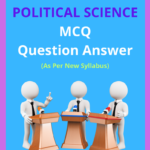Class 11 Political Science Chapter 20 Development Solutions to each chapter is provided in the list so that you can easily browse throughout different chapters NCERT Class 11 Political Science Chapter 20 Development and select need one.
Class 11 Political Science Chapter 20 Development
Also, you can read the AHSEC book online in these sections Solutions by Expert Teachers as per AHSEC (CBSE) Book guidelines. These solutions are part of AHSEC All Subject Solutions. Here we have given Assam Board Class 11 Political Science Chapter 20 Development Solutions for All Subjects, You can practice these here.
Development
Chapter – 20
POLITICAL SCIENCE
TEXTUAL QUESTIONS AND ANSWERS
PART – B
Q.1. What do you mean by Development?
Ans : Development is Universal it is a world-wide concept which means differently in different context. The Bandit commission-“Development never will be and never can be defined to universal satisfaction “For some, development means increase in national economy, for others, it implies social development, for modernization. Easman says, “Development, is the rational process of organizing and carrying out prudently conceived and staffed programmes or project or one would organize and carry our military or engineering operations. “To column and greige, development means change, change coupled with growth, widener holds the view that when a process is directed towards nation building and socio economic Progress, that process of growth is development.
Q.2. What is under Development?
Ans : It means absence of development. In other words, it is considered to be some thing that is static. It is too limited a meaning of underdevelopment when it is seen as static. Attempts have been made to view it as a process, Gunnar Myndal Understands it as a process, a process of cumulative circular causation among such factors or levels of living, income and productivity. Accordingly, he says that low level of living, low levels of productivity and low incomes act in a vicious cycle to result in underdevelopment. Underdevelopment is not something static, but is something that is related to the political, economic and ecological environment. If we understand underdevelopment as a process that tends to result in low lev. of life. We can reverse it , if by it we mean a process after making chan, sin economic, social and political structures.
Q.3. Define development in the words of Riggs.
Ans : Riggs gives rather a detailed definition, “Development involves the ability to choose, whether or not to increase outputs, whether or not raise levels of per capita income, or to direct energies to other goals . to the more equitable distribution of what is available, to aesthetic or spiritual values, or the qualitatively to very deterrent kings of outputs. : Mittleme refers to development as the increasing capacity to make rational use of natural and human resources for social ends. Baron says that development means far reaching transformation of society’s economic, social and political structure of the dominant organization of production, distribution and consumption.
Q.4. What are the features and implication of development?
Ans : (i) Development is not a static concept :- It is a dynamic, and hence, an ever changing and oven-evolving concept, and can not imagine any thing in a ‘developed form, for every developed form still needs some improvement Development is, thus a continuing term.
(ii) Development is not unidimensional, but is a multi dimensional process :- This means that development is not only economic development, it is also social development as also political or any other aspect. Its goals are not confined to economy merely they touch every aspect of human and social life, they may, to mention a few, include economic growth. social progress, and political development, nation-building and the like.
(iii) Development implies growth :- What it means is that all societies keep growing, expending advancing and therefore, are in the process of change ever changing, The present society of a country is different from such a society of another, country; today’s society is not what its was yesterday, in the past; like wise the future society would be substantially different from the society we find around us.
(iv) Development is closely relaters to technology :- In essence, a technologically advanced society is a developed society. Technology has changed and infect to changing our life each impact of the life. Technology has made the world very small.
(v) Rationality constitutions yet another component of development :- What it means is that developed society is not tradition bound or religion leader, but is one that stands up to reasoning and rationalism.
(vi) Development has yet other features or requisites as well :- Order, stability, security and the like prepare a ground for sustained growth. Countries have grown in years of peace rather than in times of war. As development mean change with growth, it implies substantial changes in the infrastructure as will. You can not run an import-export business without a developed banking system.
Q.5. What is modernization ?
Ans : If development is viewed as process meaning thereby, change with growth, it is a concept related very closely to modernization. It is therefore, not surprising that “Development and modernization. It is, therefore not surprising that development and modernization are more or less, interchangeable. Daviel leaner defines the term ‘modernizations as a ‘systematic process involving complement way changes in the demographic economic political communication and cultural sectors of a society. Rostow and ward say that modernization “involves a market inhered in geographic and social mobility, a spread of secular, Scientific and technical education, a transition from ascribed status, an increase in material standards of living, and many related and subsidiary phenomenon.
Q.6. Write a note or the welfare model in crisis.
Ans : The welfare Model in crisis. The concept of welfare state which arose as a result of expectations of providing basic needs to the people or atleast employment failed in its objective. Especially in 1970s and after we find welfare state in crisis. This is evident not only in the field of employment but in varied fields of trade, industrial development, social welfare, integration, domestic. Politics, environment, security and defence.
This crisis is due to the stagnating economy which seems to be devoid of scope for further expansion. In Europe and America we witness a strong political movement opposing the welfare state. The neo-liberals go back to the market model of development. They are, in particular, against the increasing powers of the state. Milton Friedman said, “To the free man, the country is the collection of individuals which compose it, The scope of government must be limited to preserve law and order, to enforce private contracts, to foster competitive markets.
“Fried man has been supported by other neoliberals like Friedrich Tayok. There is also a strong demand to locate the expenses in social security and other welfare measures president Reagan in America and Prime Minister Thatcher in England had started the policy of going back to the market model. This further in creased unemployment and inflation resulting in a wave of political violence and racism. In India we witness the rise of so-called dalit politics which wants quick economic and social results, and which is not contented to wait. The market model of development resulted in severe economic disparities and exploitation. It failed in satisfying the common good. The socialist development model also failed and now the welfare model is also witnessing the failure. The problem and the resultant crisis is very severe as there is a revolution of resign expectations among the masses. But going back to market model is no solution. It will only further on archy.
| Sl. No. | CONTENTS |
| Unit 1 | PART – A |
| Chapter 1 | Constitution: Why and How? |
| Chapter 2 | Rights in the Indian Constitution |
| Chapter 3 | System of Representational Democracy |
| Chapter 4 | Executive |
| Chapter 5 | Legislature |
| Chapter 6 | Judiciary |
| Chapter 7 | Federalism |
| Chapter 8 | Local Government |
| Chapter 9 | Constitution as a Living Document |
| Chapter 10 | The Philosophy of the Constitution |
| Unit 2 | PART – B |
| Chapter 1 | Introduction to Political Theory |
| Chapter 2 | Freedom |
| Chapter 3 | Equality |
| Chapter 4 | Social Justice |
| Chapter 5 | Rights |
| Chapter 6 | Citizenship |
| Chapter 7 | Nationalism |
| Chapter 8 | Secularism |
| Chapter 9 | Peace |
| Chapter 10 | Development |
Q.7. Explain the Gandhian Model of Development.
Ans : Gandhian Model of Development Gandhi was peculiar mixture of opposites. He was not Marxist but he did care for the poor and the needy; he was not a socialist but he liked to do his own work himself without employing any one for his Jobs; he was not a capitalist but he had always advocated a self sufficient economy; he was not a liberal but he did not want to deprive the capitalist of his property. He was a Marxist, a socialist a liberal, an anarchist all in his own right.
The Gandhian view of development was not, in any case, a model of material development. He was a great critic of western capitalist system for its being exploitative and oppressive. By development, he did not mean accessibility to all material comforts but the one which leads to the development of individual, and his personality his virtues his values, his self. All material comforts but the one which leads to the development of individual and his personality, his virtues, his values, his self. All material development which the world had attained through development which the world had attained through private property did not attract Gandhi. He regarded possession as a crime, saying
I can only possess certain things when I know that others who also want to posses similar things. are able to do so “In a way Gandhi’s view that it is immoral to have more that one needs is a view which is more profound then proudhon’s who has said that all property was theft. Gandhi believed that its is God who pervades everything and hence, nothing belongs to any particular being. For him, the capitalist is a s good a servant of what he possesses as is the worker who produces value through his labour at best the capitalist is trustee this was the crux of Gandhi’s theory of trusteeship Following Marx, Gandhi thought of economic equality’s one where the needs of all are satisfied.
To each cording to his needs the Marxian pronouncement, to a situation where an individual takes as is necessary for sustenance, But that does not mean that Gandhi was either a Marxist or a non Marxist socialist. His major difference which these two strands was the method through which the new social order would usher. He never through class struggles, violence or revolutions as locomotives of history. He used to say. This I do say, fearlessly and firmly, that every worthy object can be achieved by the use of satyagraha. It is the highest and and infallible means, the greatest force. Socialism will not be reached by any means.” With firm benefits in non-violence, Gandhi’s view of development was what may be termed as ‘sarvodaya’ the welfare of all including that of the humble the lowly, and the last as also the worker, the capitalist the landlord. To that extent, Gandhi was close to marx. But unlike Marx Gandhi Sought classless society without classes, classes with out antagonism, antagonism without destroying the individuals, individuals with their conversion into human beings finer human brings. Gandhi’s theory of trusteeship is neither a complete abolition of capitalism for he marks a claim for the capital.
No it is completes acceptance of Marxian, for he makes the capitalist stay the capitalist an a trustee. It is a theory which provides a means of trans forming the present capitalist order of society into an egalitarian one, If gives no quantum to capitalism, but gives the present owning class chance of reforming itselfs to the working class a chance to contribute to the social good.
Gandhi was a simple man, a simple villager, a simple Indian villager. His view of development measured materialistically if one insists on, would be a self sufficient village. He said “An ideal Indian village will be so constructed as to lend itself to perfect sanitation, if will have cottages with sufficient lights and ventilation built of material obtainable within a radius of five mile of it.
8. Write a note on the adverse impact of development on ecology.
Ans : The rapid growing population and economic development is leading to a number of environmental issues in India because of the uncontrolled growth of urbanization and industrialization, expansion and massive intensification of agriculture, and the destruction of forests. Major environmental issues are forest and agricultural degradation of land. resource depletion (water, mineral, forest, sand, rocks etc.), environmental degradation, public health, loss of biodiversity, loss of resilience in ecosystems, livelihood security for the poor.
It is estimated that the country’s population will increase to about 1.26 billion by the year 2016. The projected population indicates that India will be the first most populous country in the world and China will be ranking second in the year 2050. India having 18% of the world’s population on 2.4% of world’s total area has greatly increased the pressure on its natural resources. Water shortages, soil exhaustion and erosion, deforestation, air and water pollution afflicts many areas. India’s water supply and sanitation issues are related to many environmental issues.

Hi, I’m Dev Kirtonia, Founder & CEO of Dev Library. A website that provides all SCERT, NCERT 3 to 12, and BA, B.com, B.Sc, and Computer Science with Post Graduate Notes & Suggestions, Novel, eBooks, Biography, Quotes, Study Materials, and more.







